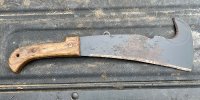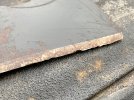No, I've never intentionally chopped a rock. Nor have I promoted such behavior. But when you are literally making hundreds, if not thousands of ground-level cuts a day, and cutting around rocks and boulders above ground, as I stated in my first post, it's not uncommon to hit rocks. Contrary to your presumptions, this was not the result of poor technique, or failure to recognize the "self-evident ", it was simply a combination of the law of averages , the requirements of the job, the conditions of the terrain, and the falibility of being human.
If there's one thing you learn when your job depends on clearing a large amount of brush day in and day out, it's which technique works best under the specific circumstances your facing. And yet, I still don't claim to be an expert.
But hey, if you could have cleared the very same areas that I cleared, in the time I did it, without hitting any rocks, I would have been thoroughly impressed. But I guess we'll never know.
And as for injuries, despite the number of times I swung my macheteI each day, each week, and each month, I never cut myself, nor anyone else. Heck, maybe I actually knew what I was doing.
But I can see this starting to go in circles. You say I wasn't using the proper technique, while I know that my technique worked just fine, because I was the one there doing the work.
If agreeing to disagree on the matter isn't good enough for you, then I don't know what else there is to say.









